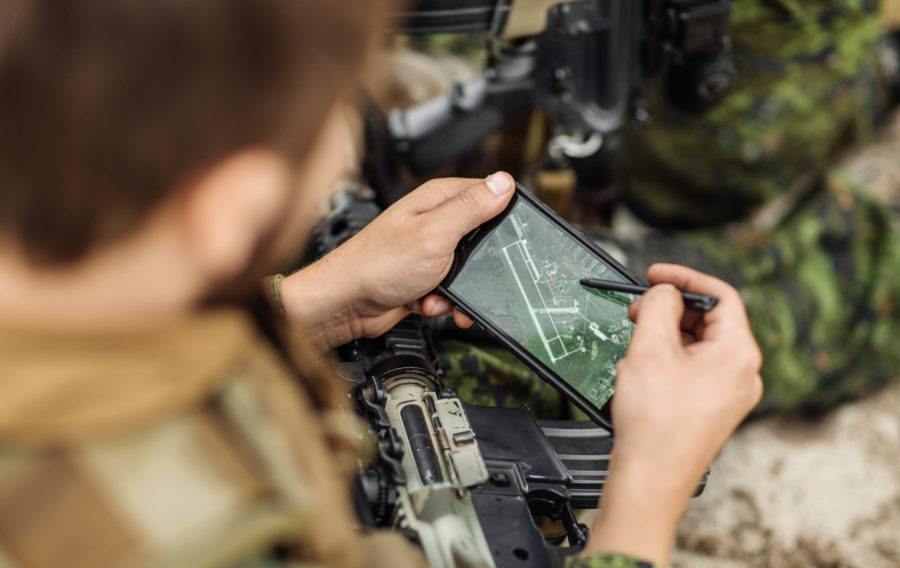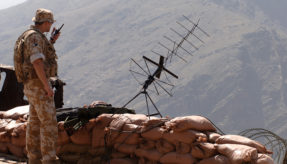
Jackson White – Sales Director UK, Ireland & Nordics at Getac UK Ltd – looks at the pitfalls and potential benefits of modernising mobile computing devices for today’s frontline soldier.
Modernisation of defence is firmly on the agenda with much focus on Command, Control, Communications, Computers, Intelligence, Surveillance and Reconnaissance (C4ISR).
It’s an estimated $83.4 billion market worldwide, which is expected to grow at a CAGR of 2.85% between 2016 and 2026 (according to the Global C4ISR Market 2016-2026 report by Absolute Reports).
The demand for C4ISR systems is being driven by the need to achieve modernisation, a rise in asymmetric warfare and the growing requirement for flexible interoperability and integration of systems and networks to support military and dismounted operations.
An important goal of C4ISR is for each soldier’s capability to be enhanced and for technology to be a force multiplier. One of the most important technologies for the dismounted soldier is their End User Device (EUD), as it enables rapid access to – and manipulation of – data in real time, collaboration and integration of applications. Yet, traditionally specialist mobile devices have been power-hungry,heavy and cumbersome.
Now devices have become smaller and more powerful in the consumer realm, and defence is eager to adopt this capability in the battlefield. It’s easy to see why when considering the benefits of consumer mobile devices; they are small, lightweight and fast, easy to use, intuitive, and have interoperable operating systems, loaded with apps. However, consumer devices will quickly fail in military environments – especially in the deployed space. Robust standards have to be met before a device can be considered by the military. Security is the obvious one, but so are reliability and resilience to withstand harsh or extreme environments, as well as interoperability with other necessary technology used by defence personnel. There are other factors too, such as cost, usability, fitness for purpose and longevity.
So, how can defence procurement teams choose the right mobile device that meets the standards and security requirements of the C4ISR environment?
Security
Equipping dismounted soldiers with the technology that allows them to securely access and manipulate sensitive and critical data is a necessity; it could mean the difference between a successful and a failed mission, or even between life and death itself. With the threats of cyber warfare, hacking systems and infiltration, security of data continues to be the top consideration for any defence digitisation strategy.
To meet the highest military data classification standards, data needs to be encrypted and protected against attack, theft or intercept when it is at rest, in use or in transit. This means both hardware and software have to be encrypted, and extends to system hardening, peripheral control and centralised management, all of which significantly improves the ability to control devices, enforce security policies and provide audit trails and reporting, while reducing support and maintenance overheads. Administrators can have complete control to create separate encrypted user accounts or personas, enforce strong authentication and manage different application and device policies. To counter any limitations of software and hardware encryption, blister packs and bolt-ons for specialist devices can be added that meet the hardware security requirements mandated by government.
Procurement teams should ensure devices meet the standards published by national security authorities such as the US Common Criteria ISO/IEC computer security certifications, the NSA’s Commercial Solutions of Classified (CSfC) platform and file encryption data at rest guidelines, which enables commercial components to be used in layered solutions to protect classified national security systems information.
Interoperability and applications
Specialist connectors are needed to integrate with other systems – either legacy or modern soldier systems – that are only made by a handful of manufacturers, and are not available on consumer-grade devices. In specialist military devices, the manufacturer can customise devices so that connections are mounted in the best location on the device depending on how and where it will be used by the soldier. Devices should be compatible with IEEE communication protocols, making them interoperable with a range of external hardware and software.
Specific third-party applications and soldier systems Battle Management Systems (BMS) can be loaded directly onto devices that have compatible operating systems. This gives the dismounted soldier access to new 3D mapping for intelligence about buildings, tunnels and heat sensors, while GPS means soldiers are better informed and can make faster decisions based on real-time information about other troops and enemies.
Environment and usability
Equipment is expected to stand the test of high-risk environments, drops, vibrations, spillages, extreme temperatures and even chemicals, but consumer devices will quickly fail in these situations. Dismounted soldiers are also often required to wear protective clothing and technology needs to work within these constraints. For example, touch-screens need to operate with gloves, and be clearly visible in different light conditions, or be compatible with night vision goggles (NVGs).
A military modernisation strategy that considers consumer devices to achieve better communication and productivity in the dismounted space is fraught with pitfalls that will inevitably lead to more expenditure. There needs to be a balance; devices that are consumer grade will inevitably not be robust or reliable enough to meet the needs of dismounted soldiers, or survive the environments they operate in. On the other hand, some specific rugged device s may be too heavy and cumbersome.
To effectively meet military C4ISR operational and modernisation goals, defence procurement must look to harness new COTS hardware and software and even Internet of Things applications. Plus for mobile computing, a new breed of ‘consumer rugged’ COT devices can provide the right balance, of being lightweight, easy to use and powerful as well as meeting stringent data and security standards.
For more information, visit: uk.getac.com
If you would like to join our community and read more articles like this then please click here.







